Abstract
Gene amplification is frequently observed in tumors and transformed cell lines. This phenomenon is known to contribute to the generation of drug-resistant tumor cells and quantitation of the event is believed to have prognostic value in several types of neoplasias. To date, most studies of gene amplification have used immortalized cell lines and biopsied tumor samples. In this study I examine the amplification potentials of primary diploid cells, both human and rodent, and quantitatively compare them to the amplification potentials of their transformed counterparts. I have used a strictly defined protocol (i.e., selection at a stringency of 9 X LD50) to measure amplification potential at two loci, the gene for the multifunctional protein containing activities for carbamoyl phosphate synthase, aspartate transcarbamylase, and dihydroorotase (CAD) and the gene for dihydrofolate reductase (DHFR). I find that the frequency of amplification in transformed cells is at least four orders of magnitude greater than that in normal cells. Out of 29 cell populations studied, the 7 diploid normal cell populations exhibited no detectable amplification frequency (limit of detection at 10(-8) whereas the 22 transformed cell lines demonstrated amplification frequencies between 10(-3) and 10(-7). These results demonstrate that a dramatic difference exists between primary diploid cell populations and immortalized cell populations in their ability to amplify genomic sequences and suggests a significant difference in genetic stability between these two cell types.
Full text
PDF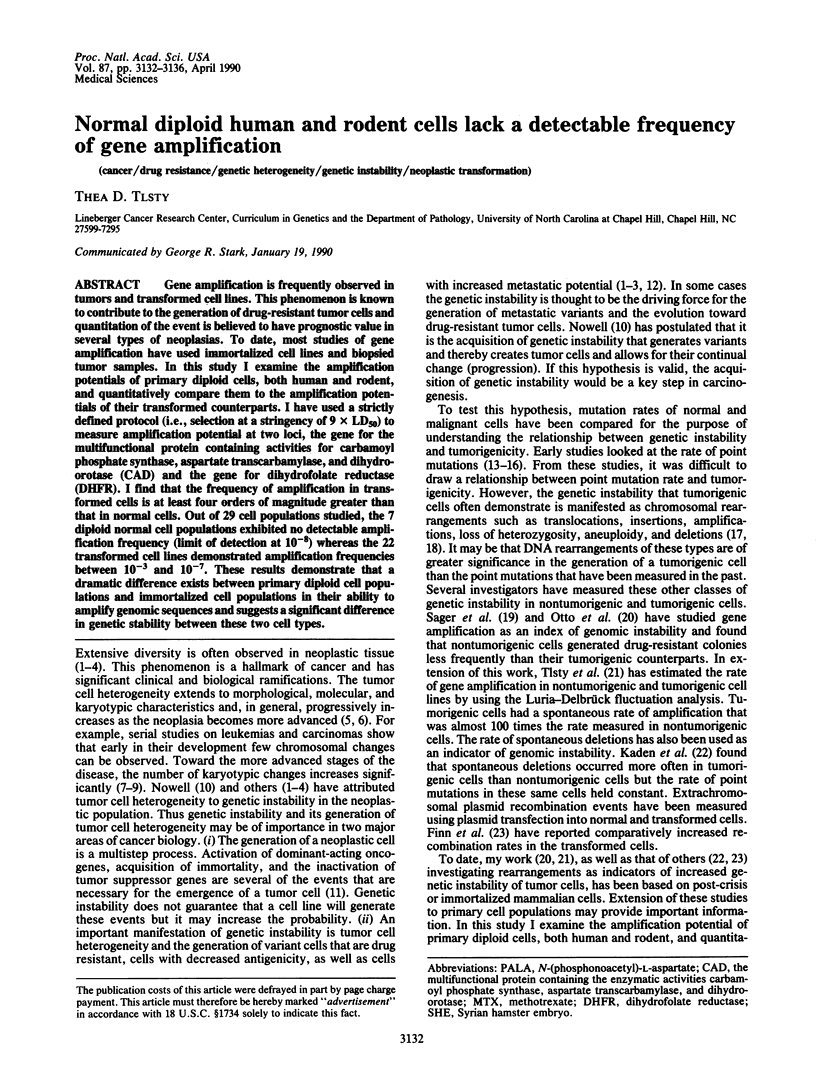
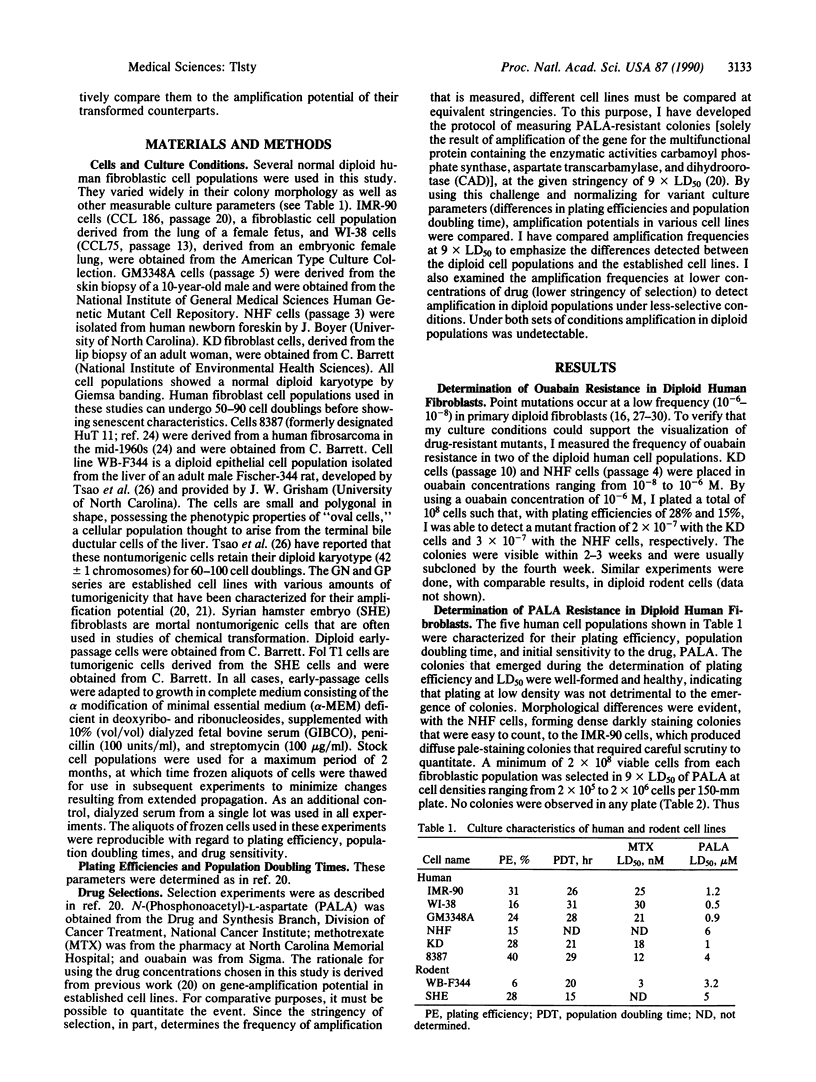
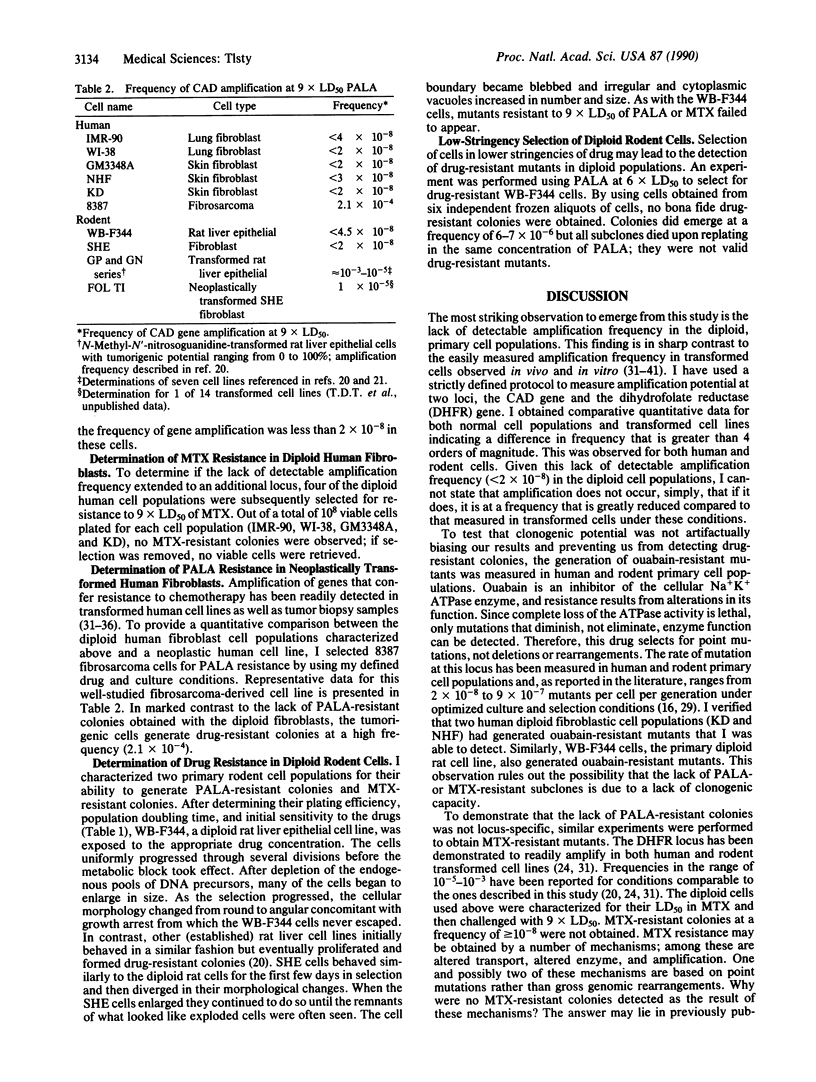
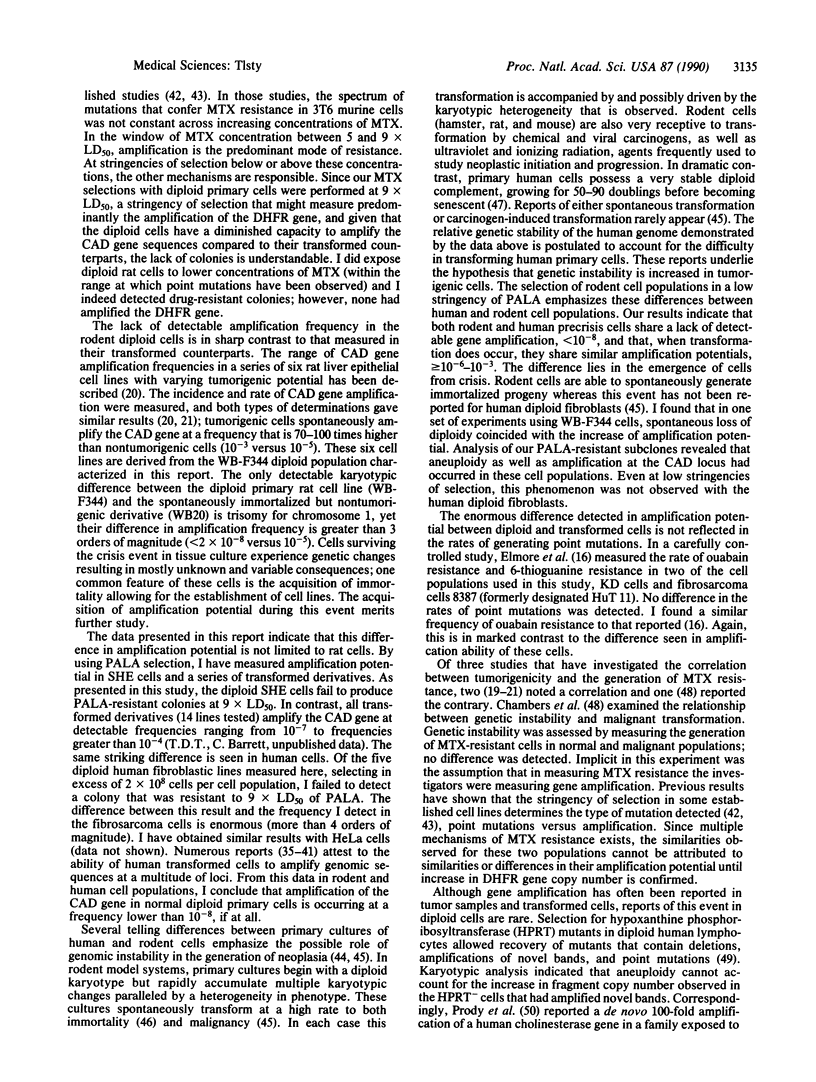
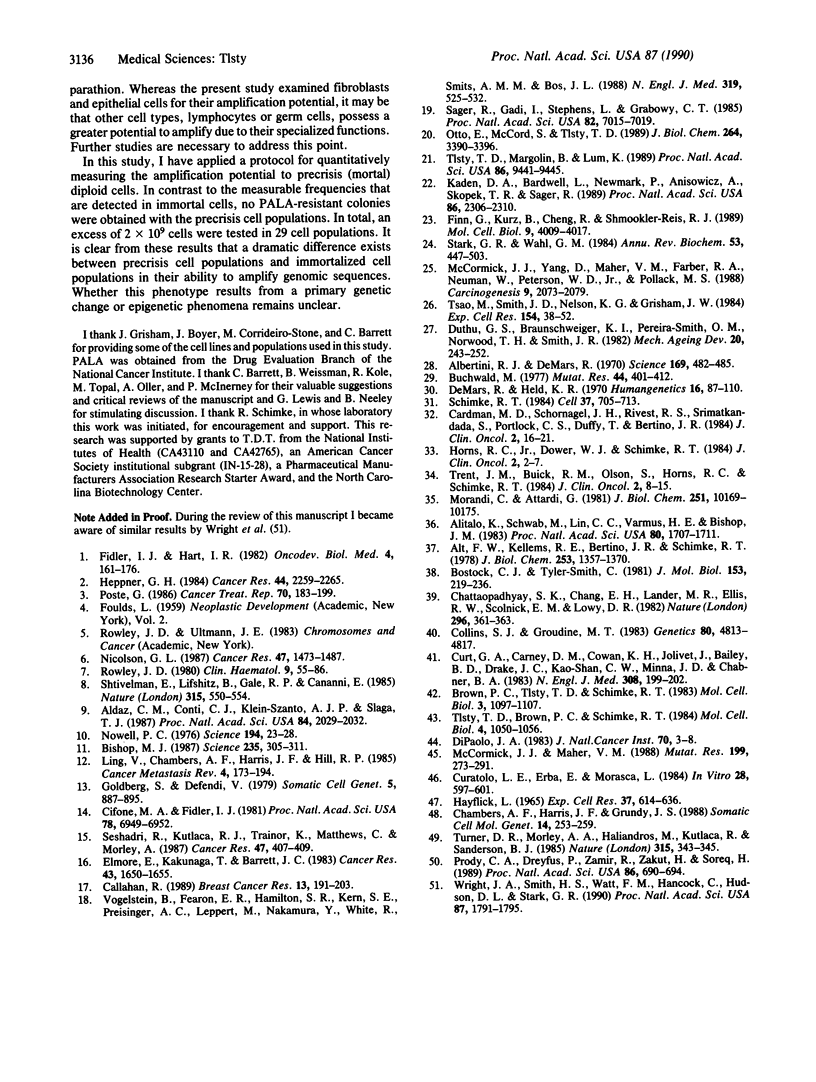
Selected References
These references are in PubMed. This may not be the complete list of references from this article.
- Albertini R. J., Demars R. Diploid azaguanine-resistant mutants of cultured human fibroblasts. Science. 1970 Jul 31;169(3944):482–485. doi: 10.1126/science.169.3944.482. [DOI] [PubMed] [Google Scholar]
- Aldaz C. M., Conti C. J., Klein-Szanto A. J., Slaga T. J. Progressive dysplasia and aneuploidy are hallmarks of mouse skin papillomas: relevance to malignancy. Proc Natl Acad Sci U S A. 1987 Apr;84(7):2029–2032. doi: 10.1073/pnas.84.7.2029. [DOI] [PMC free article] [PubMed] [Google Scholar]
- Alitalo K., Schwab M., Lin C. C., Varmus H. E., Bishop J. M. Homogeneously staining chromosomal regions contain amplified copies of an abundantly expressed cellular oncogene (c-myc) in malignant neuroendocrine cells from a human colon carcinoma. Proc Natl Acad Sci U S A. 1983 Mar;80(6):1707–1711. doi: 10.1073/pnas.80.6.1707. [DOI] [PMC free article] [PubMed] [Google Scholar]
- Alt F. W., Kellems R. E., Bertino J. R., Schimke R. T. Selective multiplication of dihydrofolate reductase genes in methotrexate-resistant variants of cultured murine cells. J Biol Chem. 1978 Mar 10;253(5):1357–1370. [PubMed] [Google Scholar]
- Bishop J. M. The molecular genetics of cancer. Science. 1987 Jan 16;235(4786):305–311. doi: 10.1126/science.3541204. [DOI] [PubMed] [Google Scholar]
- Bostock C. J., Tyler-Smith C. Gene amplification in methotrexate-resistant mouse cells. II. Rearrangement and amplification of non-dihydrofolate reductase gene sequences accompany chromosomal changes. J Mol Biol. 1981 Dec 5;153(2):219–236. doi: 10.1016/0022-2836(81)90275-8. [DOI] [PubMed] [Google Scholar]
- Brown P. C., Tlsty T. D., Schimke R. T. Enhancement of methotrexate resistance and dihydrofolate reductase gene amplification by treatment of mouse 3T6 cells with hydroxyurea. Mol Cell Biol. 1983 Jun;3(6):1097–1107. doi: 10.1128/mcb.3.6.1097. [DOI] [PMC free article] [PubMed] [Google Scholar]
- Buchwald M. Mutagenesis at the ouabain-resistance locus in human diploid fibroblasts. Mutat Res. 1977 Sep;44(3):401–411. doi: 10.1016/0027-5107(77)90098-7. [DOI] [PubMed] [Google Scholar]
- Callahan R. Genetic alterations in primary breast cancer. Breast Cancer Res Treat. 1989 Jul;13(3):191–203. doi: 10.1007/BF02106570. [DOI] [PubMed] [Google Scholar]
- Carman M. D., Schornagel J. H., Rivest R. S., Srimatkandada S., Portlock C. S., Duffy T., Bertino J. R. Resistance to methotrexate due to gene amplification in a patient with acute leukemia. J Clin Oncol. 1984 Jan;2(1):16–20. doi: 10.1200/JCO.1984.2.1.16. [DOI] [PubMed] [Google Scholar]
- Chambers A. F., Harris J. F., Grundy J. S. Rates of generation of methotrexate-resistant variants in cells temperature-sensitive for malignant transformation. Somat Cell Mol Genet. 1988 May;14(3):253–259. doi: 10.1007/BF01534586. [DOI] [PubMed] [Google Scholar]
- Chattopadhyay S. K., Chang E. H., Lander M. R., Ellis R. W., Scolnick E. M., Lowy D. R. Amplification and rearrangement of onc genes in mammalian species. Nature. 1982 Mar 25;296(5855):361–363. doi: 10.1038/296361a0. [DOI] [PubMed] [Google Scholar]
- Cifone M. A., Fidler I. J. Increasing metastatic potential is associated with increasing genetic instability of clones isolated from murine neoplasms. Proc Natl Acad Sci U S A. 1981 Nov;78(11):6949–6952. doi: 10.1073/pnas.78.11.6949. [DOI] [PMC free article] [PubMed] [Google Scholar]
- Collins S. J., Groudine M. T. Rearrangement and amplification of c-abl sequences in the human chronic myelogenous leukemia cell line K-562. Proc Natl Acad Sci U S A. 1983 Aug;80(15):4813–4817. doi: 10.1073/pnas.80.15.4813. [DOI] [PMC free article] [PubMed] [Google Scholar]
- Curatolo L., Erba E., Morasca L. Culture conditions induce the appearance of immortalized C3H mouse cell lines. In Vitro. 1984 Aug;20(8):597–601. doi: 10.1007/BF02619607. [DOI] [PubMed] [Google Scholar]
- Curt G. A., Carney D. N., Cowan K. H., Jolivet J., Bailey B. D., Drake J. C., Chien Song K. S., Minna J. D., Chabner B. A. Unstable methotrexate resistance in human small-cell carcinoma associated with double minute chromosomes. N Engl J Med. 1983 Jan 27;308(4):199–202. doi: 10.1056/NEJM198301273080406. [DOI] [PubMed] [Google Scholar]
- DeMars R., Held K. R. The spontaneous azaguanine-resistant mutants of diploid human fibroblasts. Humangenetik. 1972;16(1):87–110. doi: 10.1007/BF00393992. [DOI] [PubMed] [Google Scholar]
- DiPaolo J. A. Relative difficulties in transforming human and animal cells in vitro. J Natl Cancer Inst. 1983 Jan;70(1):3–8. [PubMed] [Google Scholar]
- Duthu G. S., Braunschweiger K. I., Pereira-Smith O. M., Norwood T. H., Smith J. R. A long-lived human diploid fibroblast line for cellular aging studies: applications in cell hybridization. Mech Ageing Dev. 1982 Nov;20(3):243–252. doi: 10.1016/0047-6374(82)90091-4. [DOI] [PubMed] [Google Scholar]
- Elmore E., Kakunaga T., Barrett J. C. Comparison of spontaneous mutation rates of normal and chemically transformed human skin fibroblasts. Cancer Res. 1983 Apr;43(4):1650–1655. [PubMed] [Google Scholar]
- Fidler I. J., Hart I. R. The development of biological diversity and metastatic potential in malignant neoplasms. Oncodev Biol Med. 1982;4(1-2):161–176. [PubMed] [Google Scholar]
- Finn G. K., Kurz B. W., Cheng R. Z., Shmookler Reis R. J. Homologous plasmid recombination is elevated in immortally transformed cells. Mol Cell Biol. 1989 Sep;9(9):4009–4017. doi: 10.1128/mcb.9.9.4009. [DOI] [PMC free article] [PubMed] [Google Scholar]
- Goldberg S., Defendi V. Increased mutation rates in doubly viral transformed Chinese hamster cells. Somatic Cell Genet. 1979 Nov;5(6):887–895. doi: 10.1007/BF01542648. [DOI] [PubMed] [Google Scholar]
- HAYFLICK L. THE LIMITED IN VITRO LIFETIME OF HUMAN DIPLOID CELL STRAINS. Exp Cell Res. 1965 Mar;37:614–636. doi: 10.1016/0014-4827(65)90211-9. [DOI] [PubMed] [Google Scholar]
- Heppner G. H. Tumor heterogeneity. Cancer Res. 1984 Jun;44(6):2259–2265. [PubMed] [Google Scholar]
- Horns R. C., Jr, Dower W. J., Schimke R. T. Gene amplification in a leukemic patient treated with methotrexate. J Clin Oncol. 1984 Jan;2(1):2–7. doi: 10.1200/JCO.1984.2.1.2. [DOI] [PubMed] [Google Scholar]
- Kaden D. A., Bardwell L., Newmark P., Anisowicz A., Skopek T. R., Sager R. High frequency of large spontaneous deletions of DNA in tumor-derived CHEF cells. Proc Natl Acad Sci U S A. 1989 Apr;86(7):2306–2310. doi: 10.1073/pnas.86.7.2306. [DOI] [PMC free article] [PubMed] [Google Scholar]
- Ling V., Chambers A. F., Harris J. F., Hill R. P. Quantitative genetic analysis of tumor progression. Cancer Metastasis Rev. 1985;4(2):173–192. doi: 10.1007/BF00050694. [DOI] [PubMed] [Google Scholar]
- McCormick J. J., Maher V. M. Towards an understanding of the malignant transformation of diploid human fibroblasts. Mutat Res. 1988 Jun;199(2):273–291. doi: 10.1016/0027-5107(88)90209-6. [DOI] [PubMed] [Google Scholar]
- McCormick J. J., Yang D. J., Maher V. M., Farber R. A., Neuman W., Peterson W. D., Jr, Pollack M. S. The HuT series of 'carcinogen-transformed' human fibroblast cell lines are derived from the human fibrosarcoma cell line 8387. Carcinogenesis. 1988 Nov;9(11):2073–2079. doi: 10.1093/carcin/9.11.2073. [DOI] [PubMed] [Google Scholar]
- Morandi C., Attardi G. Isolation and characterization of dihydrofolic acid reductase from methotrexate-sensitive and -resistant human cell lines. J Biol Chem. 1981 Oct 10;256(19):10169–10175. [PubMed] [Google Scholar]
- Nicolson G. L. Tumor cell instability, diversification, and progression to the metastatic phenotype: from oncogene to oncofetal expression. Cancer Res. 1987 Mar 15;47(6):1473–1487. [PubMed] [Google Scholar]
- Nowell P. C. The clonal evolution of tumor cell populations. Science. 1976 Oct 1;194(4260):23–28. doi: 10.1126/science.959840. [DOI] [PubMed] [Google Scholar]
- Otto E., McCord S., Tlsty T. D. Increased incidence of CAD gene amplification in tumorigenic rat lines as an indicator of genomic instability of neoplastic cells. J Biol Chem. 1989 Feb 25;264(6):3390–3396. [PubMed] [Google Scholar]
- Poste G. Pathogenesis of metastatic disease: implications for current therapy and for the development of new therapeutic strategies. Cancer Treat Rep. 1986 Jan;70(1):183–199. [PubMed] [Google Scholar]
- Prody C. A., Dreyfus P., Zamir R., Zakut H., Soreq H. De novo amplification within a "silent" human cholinesterase gene in a family subjected to prolonged exposure to organophosphorous insecticides. Proc Natl Acad Sci U S A. 1989 Jan;86(2):690–694. doi: 10.1073/pnas.86.2.690. [DOI] [PMC free article] [PubMed] [Google Scholar]
- Rowley J. D. Ph1-positive leukaemia, including chronic myelogenous leukaemia. Clin Haematol. 1980 Feb;9(1):55–86. [PubMed] [Google Scholar]
- Sager R., Gadi I. K., Stephens L., Grabowy C. T. Gene amplification: an example of accelerated evolution in tumorigenic cells. Proc Natl Acad Sci U S A. 1985 Oct;82(20):7015–7019. doi: 10.1073/pnas.82.20.7015. [DOI] [PMC free article] [PubMed] [Google Scholar]
- Schimke R. T. Gene amplification in cultured animal cells. Cell. 1984 Jul;37(3):705–713. doi: 10.1016/0092-8674(84)90406-9. [DOI] [PubMed] [Google Scholar]
- Seshadri R., Kutlaca R. J., Trainor K., Matthews C., Morley A. A. Mutation rate of normal and malignant human lymphocytes. Cancer Res. 1987 Jan 15;47(2):407–409. [PubMed] [Google Scholar]
- Shtivelman E., Lifshitz B., Gale R. P., Canaani E. Fused transcript of abl and bcr genes in chronic myelogenous leukaemia. Nature. 1985 Jun 13;315(6020):550–554. doi: 10.1038/315550a0. [DOI] [PubMed] [Google Scholar]
- Stark G. R., Wahl G. M. Gene amplification. Annu Rev Biochem. 1984;53:447–491. doi: 10.1146/annurev.bi.53.070184.002311. [DOI] [PubMed] [Google Scholar]
- Tlsty T. D., Brown P. C., Schimke R. T. UV radiation facilitates methotrexate resistance and amplification of the dihydrofolate reductase gene in cultured 3T6 mouse cells. Mol Cell Biol. 1984 Jun;4(6):1050–1056. doi: 10.1128/mcb.4.6.1050. [DOI] [PMC free article] [PubMed] [Google Scholar]
- Tlsty T. D., Margolin B. H., Lum K. Differences in the rates of gene amplification in nontumorigenic and tumorigenic cell lines as measured by Luria-Delbrück fluctuation analysis. Proc Natl Acad Sci U S A. 1989 Dec;86(23):9441–9445. doi: 10.1073/pnas.86.23.9441. [DOI] [PMC free article] [PubMed] [Google Scholar]
- Trent J. M., Buick R. N., Olson S., Horns R. C., Jr, Schimke R. T. Cytologic evidence for gene amplification in methotrexate-resistant cells obtained from a patient with ovarian adenocarcinoma. J Clin Oncol. 1984 Jan;2(1):8–15. doi: 10.1200/JCO.1984.2.1.8. [DOI] [PubMed] [Google Scholar]
- Tsao M. S., Smith J. D., Nelson K. G., Grisham J. W. A diploid epithelial cell line from normal adult rat liver with phenotypic properties of 'oval' cells. Exp Cell Res. 1984 Sep;154(1):38–52. doi: 10.1016/0014-4827(84)90666-9. [DOI] [PubMed] [Google Scholar]
- Turner D. R., Morley A. A., Haliandros M., Kutlaca R., Sanderson B. J. In vivo somatic mutations in human lymphocytes frequently result from major gene alterations. Nature. 1985 May 23;315(6017):343–345. doi: 10.1038/315343a0. [DOI] [PubMed] [Google Scholar]
- Vogelstein B., Fearon E. R., Hamilton S. R., Kern S. E., Preisinger A. C., Leppert M., Nakamura Y., White R., Smits A. M., Bos J. L. Genetic alterations during colorectal-tumor development. N Engl J Med. 1988 Sep 1;319(9):525–532. doi: 10.1056/NEJM198809013190901. [DOI] [PubMed] [Google Scholar]
- Wright J. A., Smith H. S., Watt F. M., Hancock M. C., Hudson D. L., Stark G. R. DNA amplification is rare in normal human cells. Proc Natl Acad Sci U S A. 1990 Mar;87(5):1791–1795. doi: 10.1073/pnas.87.5.1791. [DOI] [PMC free article] [PubMed] [Google Scholar]


